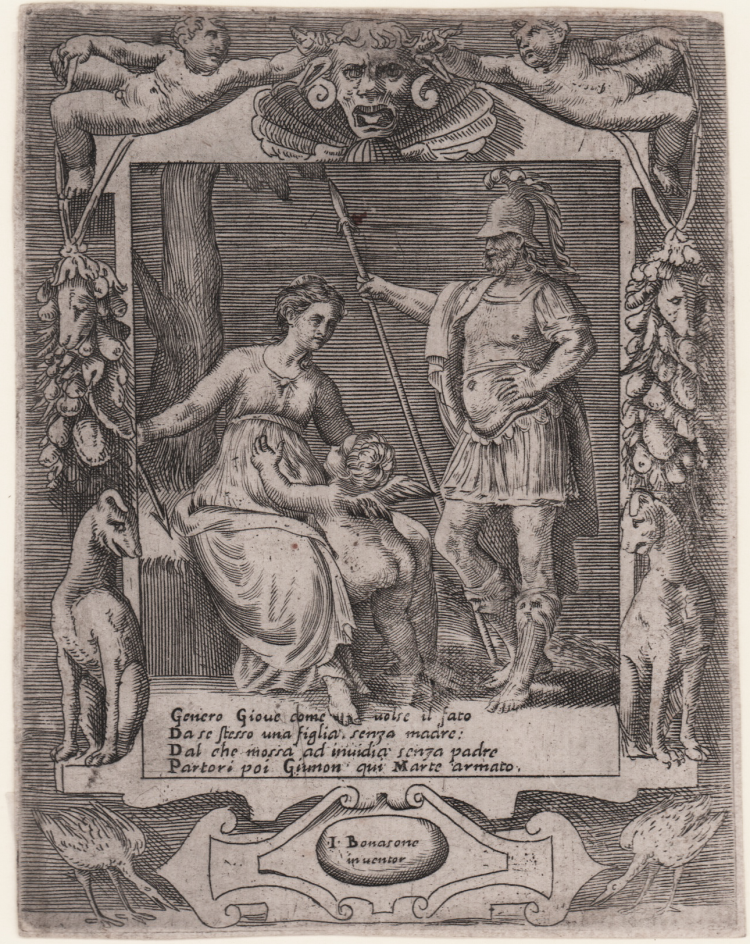



| Reference: | S35313 |
| Author | Giulio BONASONE |
| Year: | 1568 ca. |
| Measures: | 105 x 135 mm |


| Reference: | S35313 |
| Author | Giulio BONASONE |
| Year: | 1568 ca. |
| Measures: | 105 x 135 mm |
Engraving, circa 1568, lettered with four lines of verse 'Genero Giove... and above 'I. Bonasone inventor'.
The Triumph of Juno who is seated in her chariot attended to by various women; from a series of twenty-two engravings called Amori sdegni et gielosie di Giunone (Loves, Rages and Jealousies of Juno). A series of 22 prints dedicated to the loves and jealousies of the goddess, Juno, the designs for which seem to be of Giulio's own invention. The series was heavily infleunced by artists such as Parmigianino and Titian, as noted by Bartsch, and also, by Correggio, Raphael and Marcantonio Raimondi. Each print has an ornamental frame and features verses in the bottom register, as well as Giulio's name as 'inventor'.
Bonasone was in contact with the Bolognese humanists, and he himself may have been the author of the verses at the bottom of the prints in the series. . It has been suggested by Massari that the series was perhaps commissioned by or connected to the Accademia Bocchiana, Bologna. (Stefania Massari, 'Giulio Bonasone', Vol. 1, Rome, 1983, p. 115). The title page of the series in fact shows Athena and Mercury, the same gods that as symbols of the academy adorn Palazzo Bocchi in the facade engraving. As the frontispiece shows, the title of the series is Juno's loves, revenges, and jealousies. The choice of Juno is itself iconographically rare if not unique in the Renaissance. With the exception of the frontispiece each engraving contains a few verses, composed in Italian that explain the image and make clear the educational intent of the series. There are several main themes that emerge from reading the verses. One of these is the fate of those who defy religious authority. A second theme is one that promotes the concept of the glory of heaven and man's inability to understand God's reasoning. Finally, a third theme is given by the function of educator or intermediary attributed to Juno, maternal and protective qualities also applicable to the Virgin.
A good impression, on contemporary laid paper, trimmed to the platemark, good condition.
Bibliografia
Bartsch, Le Peintre graveur (XV.145.115); Massari 1983, Giulio Bonasone, n. 196.
Giulio BONASONE (Bologna circa 1500 - Roma circa 1580)
|
Giulio Bonasone was born in Bologna in 1510; he was engraver, etcher and, as a painter, he was a pupil of Lorenzo Sabbatici.
The critics have ascribed to him 400 prints; nearly all of them are kept nowadays in the Institute of Graphic Design in Rome, widening the list of Bartsch, who had identified just 354 subjects. Bonasone started working in 1531 as copperplate engraver, as it can be seen from his S. Cecilia, and he was considered a follower of Marcantonio’s style in the last years. But Bonasone showed his own style quite soon, for Parmigianino asked him to engrave many of his works.
He lived in Rome between 1544 and 1547, working for the most important publishers of the time (Salamanca, Barlacchi, Lafrery), engraving subjects from Michelangelo, Raphael, Giulio Romano, Perin del Vaga and Polidoro da Caravaggio with his peculiar style.
|
Giulio BONASONE (Bologna circa 1500 - Roma circa 1580)
|
Giulio Bonasone was born in Bologna in 1510; he was engraver, etcher and, as a painter, he was a pupil of Lorenzo Sabbatici.
The critics have ascribed to him 400 prints; nearly all of them are kept nowadays in the Institute of Graphic Design in Rome, widening the list of Bartsch, who had identified just 354 subjects. Bonasone started working in 1531 as copperplate engraver, as it can be seen from his S. Cecilia, and he was considered a follower of Marcantonio’s style in the last years. But Bonasone showed his own style quite soon, for Parmigianino asked him to engrave many of his works.
He lived in Rome between 1544 and 1547, working for the most important publishers of the time (Salamanca, Barlacchi, Lafrery), engraving subjects from Michelangelo, Raphael, Giulio Romano, Perin del Vaga and Polidoro da Caravaggio with his peculiar style.
|